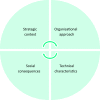Health information technology in hospitals: current issues and future trends
- PMID: 31098079
- PMCID: PMC6465875
- DOI: 10.7861/futurehosp.2-1-50
Health information technology in hospitals: current issues and future trends
Abstract
Healthcare is at an important crossroads in that current models of care are increasingly seen by politicians and policymakers as unsustainable. Furthermore, there is a need to move away from the reactive, doctor-centred model of care to one that is more patient-centred and that consistently delivers accessible, high-quality and safe care to all. Greater use of health information technology (HIT) is seen by many key decision makers as crucial to this transformation process and, hence, substantial investments are made in this area. However, healthcare, particularly in UK hospitals, remains a laggard in HIT adoption. To uncover the underlying reasons, we discuss current implementation and adoption challenges and explore potential ways to address these. We outline strategic, organisational, technical and social factors that can 'make or break' technological implementations. Most importantly, we suggest that efforts should be characterised by an underlying awareness of the complexity of the hospital environment and the need to develop tools that support provision of integrated multidisciplinary care. We conclude with a discussion of promising future developments, including increased patient involvement; access and contribution to shared records; the penetration of smart devices; greater health information exchange and interoperability; and innovative real-time secondary uses of data. We argue that there is considerable merit in evaluating the introduction of these interventions to help ensure that they are optimised for effectiveness, support efficient working and minimise the possibility of inadvertently introducing new risks into already complex health systems. Our over-riding message is that HIT should be seen as, where appropriate, a potential enabler and an important source of data to support healthcare redesign and that critical, ongoing evaluation is key to maximising benefits. However, it should not be seen as a silver bullet.
Keywords: Health information technology; adoption; hospitals; implementation.
Figures
References
-
- BBC , 2014. NHS errors costing billions a year – Jeremy Hunt. Available online at www.bbc.com/news/uk-29639383 [Accessed 30 November 2014].
-
- BBC , 2014. NHS needs extra cash and overhaul, say health bosses. Available online at www.bbc.co.uk/news/health-29726934 [Accessed 30 November 2014].
-
- Institute for Healthcare Improvement , 2012. Across the chasm: six aims for changing the health care system. Available online at www.ihi.org/resources/Pages/ImprovementStories/AcrosstheChasmSix AimsforChangingtheHealthCareSystem.aspx [Accessed 01/11 2014]
LinkOut - more resources
Full Text Sources


